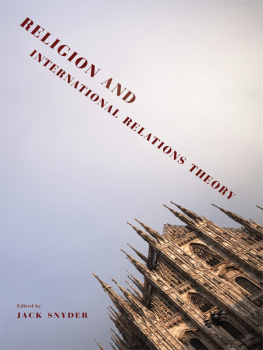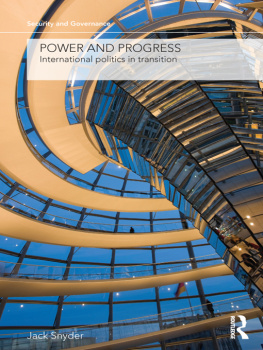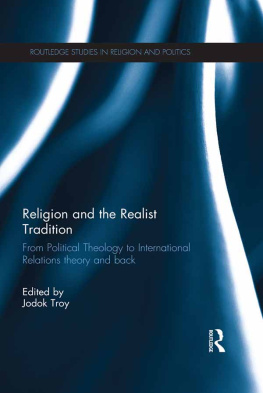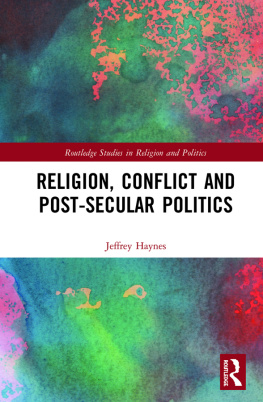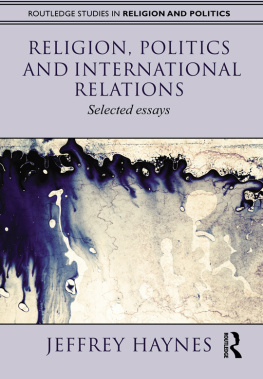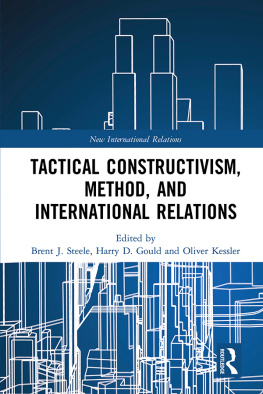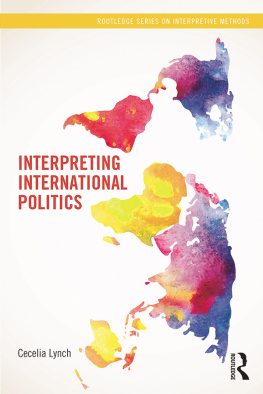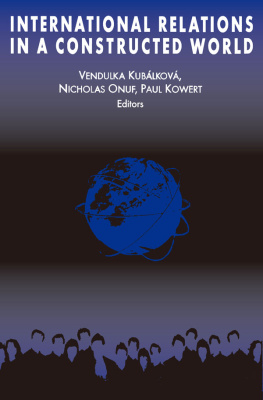Religion and International Relations Theory
RELIGION, CULTURE, AND PUBLIC LIFE
Religion, Culture, and Public Life
Series Editors: Alfred Stepan and Mark C. Taylor
The resurgence of religion calls for careful analysis and constructive criticism of new forms of intolerance, as well as new approaches to tolerance, respect, mutual understanding, and accommodation. In order to promote serious scholarship and informed debate, the Institute for Religion, Culture, and Public Life and Columbia University Press are sponsoring a book series devoted to the investigation of the role of religion in society and culture today. This series includes works by scholars in religious studies, political science, history, cultural anthropology, economics, social psychology, and other allied fields whose work sustains multidisciplinary and comparative as well as transnational analyses of historical and contemporary issues. The series focuses on issues related to questions of difference, identity, and practice within local, national, and international contexts. Special attention is paid to the ways in which religious traditions encourage conflict, violence, and intolerance and also support human rights, ecumenical values, and mutual understanding. By mediating alternative methodologies and different religious, social, and cultural traditions, books published in this series will open channels of communication that facilitate critical analysis.
After Pluralism: Reimagining Religious Engagement
Edited by Courtney Bender and Pamela E. Klassen
Religion and
International Relations Theory
Edited by Jack Snyder

COLUMBIA UNIVERSITY PRESS
NEW YORK

Columbia University Press
Publishers Since 1893
New York Chichester, West Sussex
cup.columbia.edu
Copyright 2011 Columbia University Press
All rights reserved
E-ISBN 978-0-231-52691-3
Tremendous thanks go to the Henry R. Luce Initiative on Religion and International Affairs for its generous support. A grant made it possible for the contributors to meet regularly and develop the chapters in this volume.
Library of Congress Cataloging-in-Publication Data
Religion and international relations theory / edited by Jack Snyder.
p. cm.(Religion, culture, and public life)
Includes bibliographical references and index.
ISBN 978-0-231-15338-6 (cloth : alk. paper)
ISBN 978-0-231-15339-3 (pbk. : alk. paper) ISBN
978-0-231-52691-3 (e-book)
1. Religion and international relations. I. Snyder, Jack L. II. Title. III. Series.
BL65.I55R453 2011
201'.727dc22
2010033152
A Columbia University Press E-book.
CUP would be pleased to hear about your reading experience with this e-book at .
References to Internet Web sites (URLs) were accurate at the time of writing. Neither the editor nor Columbia University Press is responsible for URLs that may have expired or changed since the manuscript was prepared.
CONTENTS
Since September 11, 2001, religion has become a central topic in discussions about international politics. Once Islamic terrorism put religion in the international spotlight, this realm suddenly seemed to teem with lively issues: the foreign policy predilections of the Christian Right for Israel and Southern Sudan, the complications of faith-based Western activism abroad, the Dalai Lama and Falun Gong as potential destabilizers of officially atheist but increasingly neo-Confucian Chin a, and the Myanmar military regimes fear of a potential alliance of Burmese monks and international refugee organizations. Perhaps religious international politics had been there all along, but it suddenly became harder to ignore.
And yet the main canonical works of international relations theory, which continue to shape much empirical academic work, hardly mention religion. A handful of new works, most of them by the contributors to this volume, have begun to show how international relations scholarship can be turned to face this new issue, but most commentary about religion and international affairs remains in the realm of current events talk, area studies, or comparative domestic politics.
One reason for this neglect is that mainstream international relations scholars find it difficult to integrate religious subject matter into their normal conceptual frameworks. The foundational statements of the three leading paradigmsby Kenneth Waltz for realism, Michael Doyle and Robert Keohane for liberalism, and Alexander Wendt for constructivismoffer no explicit guidance on how to do this, and in some cases imply that a role for religion may not be allowable within the logics of their paradigms. Realists ask, How many divisions has the Pope? Liberals tend to accept the secular modernist presumption that religion is an atavism to be superseded. Constructivism, with the central role it gives to identity, norms, and culture, has provided more natural intellectual terrain on which to integrate religion into international relations theory, and yet the index of Wendts field-defining book does not have a single entry for religion.
How then should international relations scholars conceptualize the role of religion in their work? Four approaches merit particular consideration. The first involves working within the traditional paradigms, exploring the ways in which religion has sometimes decisively shaped the states system, defined its constitutive units, and animated their interests and outlooks. I elaborate on this approach below.
A second approach, most nearly represented by Samuel Huntingtons clash of civilizations thesis, holds that religion has become so central that it should supplant existing paradigms and become the main prism for thinking about international politics. None of the contributors to this volume take this view.
However, they do argue that the role of religion in international politics has never been small and has been growing in recent decades as a form of populist politics in the developing world following the discrediting of secular political ideologies. Several contributors, especially Elizabeth Hurd, also argue that secularism can usefully be conceived not as the opposite of religion but as a comparable type of worldview that draws on and competes with religious views.
Finally, a fourth approach sidesteps paradigmatic commitments to look at more focused hypotheses in which religion is a causal variable. For example, Monica Tofts chapter in this volume examines how the characteristics of different religions affect the likelihood of war.
Whichever of these approaches is adopted, international relations specialists working on religion would do well to pay attention to the potential contributions of scholarship on comparative political development. Several of the contributors to this volume argue that the prime cause of the global resurgence of religion in politics is the rising demand for mass political participation. In the face of a perceived failure of the secular state to address popular needs, especially in the developing world, religion has become a banner for movements demanding more responsive government, whose effects have dramatically spilled over into international politics.
I will begin with a discussion of what is distinctive about religious subject matter in international relations and its implications for the kinds of theories and methods that are needed to study it. Then I will discuss the role that the paradigms, both traditional and innovative, might play in studying religion in international politics. Emily Bech and I will revisit the theme of rising demand for mass political participation in the concluding chapter.
Next page
